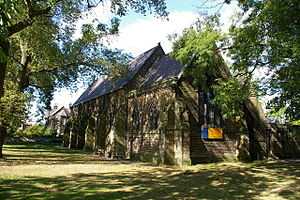Holy Trinity Church, Bury
| Holy Trinity Church, Bury | |
|---|---|
|
Holy Trinity Church, Bury, from the southeast | |
 Holy Trinity Church, Bury Location in Greater Manchester | |
| Coordinates: 53°35′20″N 2°17′20″W / 53.5890°N 2.2888°W | |
| OS grid reference | SD 810,103 |
| Location | Bury, Greater Manchester |
| Country | England |
| Denomination | Anglican |
| Website | Holy Trinity, Bury |
| Architecture | |
| Status | Parish church |
| Functional status | Redundant |
| Heritage designation | Grade II |
| Designated | 23 October 2004 |
| Architect(s) | E. G. Paley |
| Architectural type | Church |
| Style | Gothic Revival |
| Completed | 1863 |
| Specifications | |
| Materials |
Coursed rock-faced sandstone with ashlar dressings Welsh slate roofs |
| Administration | |
| Parish | Bury South East |
| Diocese | Manchester |
| Province | York |
| Clergy | |
| Assistant priest | Revd. Kieth Trivasse |
| Laity | |
| Reader(s) | Alan Thew, Pauline Dickinson |
| Organist(s) | Paul Greenwood |
| Churchwarden(s) | Margaret Nolan, Trevor Brockbank |
Holy Trinity Church is in Spring Street, Bury, Greater Manchester, England. It is a redundant Anglican parish church in the diocese of Manchester.[1] The church is recorded in the National Heritage List for England as a designated Grade II listed building.[2]
History
The church was built between 1863 and 1865 at a cost of about £5,500 (£460,000 as of 2015).[3] It was designed by the Lancaster architect E. G. Paley. The original plan included a south aisle and a north tower with a spire, but these were never built. The site was given by the 14th Earl of Derby, who also donated £1,000. As built, the church provided seating for 627 people.[4] The church was extended in about 1920.[2] On 30 November 2010 the church was declared redundant,[5] and its parish was merged with those of St Peter, Bury, and St Thomas, Bury, forming the new parish of Bury South East.[6] As of 2011, it was planned to sell it for use as a children's nursery and an early learning centre.[7]
Architecture
Holy Trinity Church is constructed in coursed rock-faced sandstone with ashlar dressings. It has Welsh slate roofs. The architectural style is Early English. Its plan consists of a nave, a north aisle with a porch, a chancel with a Lady chapel and a vestry to the north.[2] As the arcade runs down the centre of the church,[2] it is described in the Buildings of England series as a "double-naved church", with "the chancel attached to the south nave".[8] The windows at the east and west ends contain "heavy plate tracery".[8] The arcade has five bays and is carried on round piers.[8] Between the aisle and the Lady chapel is a three-bay arcade.[2] In the Lady chapel is a brightly painted reredos, added in 1987 as a First World War memorial.[8]
See also
References
- ↑ Holy Trinity, Bury, Church of England, retrieved 6 June 2011
- ↑ 2.0 2.1 2.2 2.3 2.4 Historic England. "Holy Trinity Church, Bury (1391180)". National Heritage List for England. Retrieved 7 June 2012.
- ↑ UK CPI inflation numbers based on data available from Gregory Clark (2014), "What Were the British Earnings and Prices Then? (New Series)" MeasuringWorth.
- ↑ Brandwood, Geoff; Austin, Tim; Hughes, John; Price, James (2012), The Architecture of Sharpe, Paley and Austin, Swindon: English Heritage, p. 220, ISBN 978-1-84802-049-8
- ↑ Diocese of Manchester: All Schemes (PDF), Church Commissioners/Statistics, Church of England, 2010, p. 3, retrieved 7 June 2012
- ↑ The Parish Church of St. Peter, Bury, in the Parish of Bury South East, Saint Peter's Church, Bury, retrieved 6 June 2011
- ↑ Newsletter, Friends of Friendless Churches, Autumn 2011, p. 28
- ↑ 8.0 8.1 8.2 8.3 Hartwell, Clare; Hyde, Matthew; Pevsner, Nikolaus (2004), Lancashire: Manchester and the South-East, The Buildings of England, New Haven and London: Yale University Press, p. 178, ISBN 0-300-10583-5
